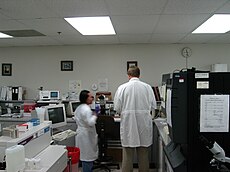
A medical laboratory or clinical laboratory is a laboratory where tests are usually done on clinical specimens in order to obtain information about the health of a patient as pertaining to the diagnosis, treatment, and prevention of disease.[1] Clinical laboratories are thus focused on applied science mainly on a production-like basis, as opposed to research laboratories that focus on basic science on an academic basis.
Departments
Laboratory medicine is generally divided into two sections, each of which being subdivided into multiple units. These two sections are
- Anatomic pathology: units included here are histopathology, cytopathology, and electron microscopy. Academically, each unit is studied alone in one course. Other courses pertaining to this section include anatomy, physiology, histology, pathology, and pathophysiology.
- Clinical pathology, which includes:
- Clinical Microbiology: This encompasses five different sciences (units). These include bacteriology, virology, parasitology, immunology, and mycology.
- Clinical Chemistry: Units under this busy section include instrumental analysis of blood components, enzymology, toxicology and endocrinology.
- Hematology: This section consists of automated and manual analysis of blood cells. It includes two subunits, which are coagulation and blood bank.
- Genetics is also studied along with a subspecialty known as cytogenetics.
- Reproductive biology: Semen analysis, Sperm bank and assisted reproductive technology.
Medical laboratory staff
The staff of clinical laboratories may include:- Pathologist
- Clinical Biochemist
- Pathologists' Assistant (PA)
- Biomedical Scientist (BMS) in the UK, Medical Laboratory Scientist (MT, MLS or CLS) in the US or Medical Laboratory Technologist in Canada
- Medical Laboratory Technician (MLT in US)
- Medical Laboratory Assistant (MLA)
- Phlebotomist (PBT)
Types of laboratory
In many countries, there are two main types of labs that process the majority of medical specimens. Hospital laboratories are attached to a hospital, and perform tests on patients. Private (or community) laboratories receive samples from general practitioners, insurance companies, clinical research sites and other health clinics for analysis. For extremely specialised tests, samples may go to a research laboratory. A lot of samples are sent between different labs for uncommon tests. It is more cost effective if a particular laboratory specializes in a rare test, receiving specimens (and money) from other labs, while sending away tests it cannot do.
In many countries there are mainly three types of Medical Laboratories as per the types of investigations carried out. 1. Clinical Pathology: Haematology, Histopathology, Cytology, Routine Pathology2. Clinical Microbiology: Bacteriology, Mycobacteriology, Virology, Mycology, Parasitology, Immunology, Serology.3. Clinical Biochemistry: Biochemical analysis, Hormonal assays etc.Blood Banks:- Blood bank is a separate body. Its laboratory need Microbiological analysis for infectious diseases that may be found in blood. Pathology to observe Blood grouping, Haematology & cross matching reactions. It also involves PRO department for the communication & contact for blood donations etc.. Molecular diagnostic lab or cytogenetics and molecular biology lab is the latest addition to the three types of medical laboratories listed above in many countries.
Medical laboratory accreditation
Credibility of medical laboratories is paramount to the health and safety of the patients relying on the testing services provided by these labs. The international standard in use today for the accreditation of medical laboratories is ISO 15189 - Medical laboratories - Requirements for quality and competence.
Accreditation is done by the Joint Commission, College of American Pathologists, AAB (American Association of Bioanalysts), and other state and federal agencies. CLIA 88 or the Clinical Laboratory Improvement Amendments also dictate testing and personnel.
The accrediting body in Australia is NATA, all laboratories must be NATA accredited to receive payment from Medicare.
In France, where accrediting body is COFRAC (COFRAC), in 2010, modification of legislation established ISO 15189 accreditation as an obligation for all clinical laboratories.[2]
In the United Arab Emirates, the Dubai Accreditation Department is the accreditation body that is internationally recognised[3] by the International Laboratory Accreditation Cooperation (ILAC) for many scopes including Medical Laboratories, Testing and Calibration Laboratories and Inspection Bodies.
In Hong Kong, the accrediting body is Hong Kong Accreditation Service (). On 16 February 2004, HKAS launched the medical testing accreditation programme.
In Canada, laboratory accreditation is not mandatory, but is becoming more and more popular. Accreditation Canada bis the national reference.

No comments:
Post a Comment